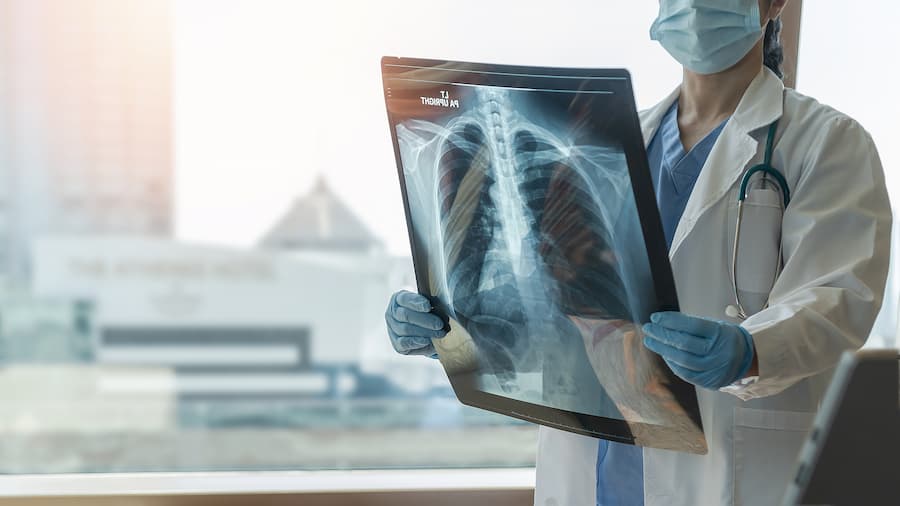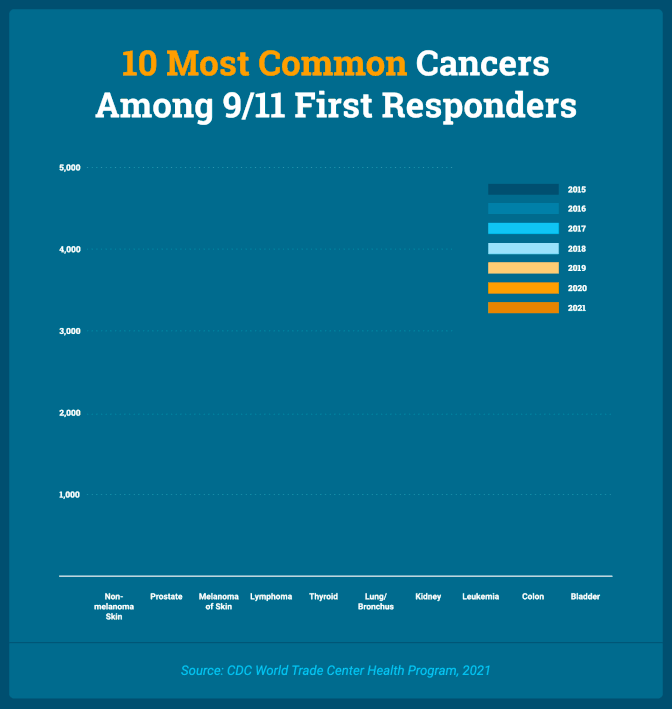What Type of Cancer Is Caused by 9/11?

500,000 people who worked, lived, went to school, and responded to the 9/11 disaster were exposed to the toxic mix of substances contained in the WTC dust plume that enveloped Lower Manhattan from 9/11 though mid-summer 2002. In the 20+ years since, over 100,000 have gotten sick with 9/11-related conditions, including many types of cancer. For more information, please reach out to our lawyers.
According to the Centers for Disease Control and Prevention (CDC)—which administers the World Trade Center Health Program (WTCHP) through its National Institute for Occupational Safety and Health (NIOSH)— there are many types of cancer caused by 9/11; in fact, cancer is the third-most-common condition resulting from 9/11 toxic exposure. More than 16,000 responders and more than 11,000 survivors (survivors are the non-first responders and include the downtown workers, residents, students, and others) obtained medical treatment and monitoring through the program for certified cancers.
The WTCHP recently certified uterine cancer as a condition caused by 9/11 exposure, for example.
Here is a look at the 15 most common cancers caused by 9/11.
1. Non-Melanoma Skin Cancer
Non-melanoma skin cancers are the most common type of cancer claimed among 9/11 survivors and responders participating in the WTCHP, with certifications for this condition received by nearly 6,000 responders and more than 1,500 survivors.
Nearly all skin cancer related to 9/11 toxic exposure qualify for certification through the program, as well as satisfying the medical condition requirement for obtaining compensation through the September 11th Victim Compensation Fund (VCF), including:
- Angiosarcoma
- Basal cell carcinoma
- Cutaneous B- and T-cell lymphoma
- Dermatafibrosarcoma protuberans
- Merkel cell carcinoma
- Sebaceous carcinoma
- Squamous cell carcinoma
The types of treatments required for non-melanoma skin cancer depend on the type of cancer that has developed. Generally, skin cancer treatment involves surgery to remove the cancer cells.
2. Prostate Cancer
Prostate cancer involves abnormal cells that develop in the prostate, which is a small, walnut-shaped gland in males that produces the seminal fluid that transports the sperm. It is not only one of the most common types of cancers suffered by 9/11 responders and survivors, but also the leading cancer diagnosis among men. More than 3,700 WTC responders and more than 2,300 survivors have obtained certifications for prostate cancer.
Prostate cancer is unpredictable. In some men, cancerous tumors in the prostate grow slowly and require minimal treatment beyond monitoring the condition for changes. However, other types of prostate cancer can be aggressive, spreading quickly to other organs. Like most cancers, those diagnosed with prostate cancer generally have the most treatment options and the highest chance of survival if you start to treat it before it spreads.
3. Breast Cancer (Female)
While 9/11-related breast cancer can occur in both females and males, female breast cancer is the third most common type of cancer among WTCHP members who are responders or survivors of the New York City terror attacks. More than 400 9/11 responders have been certified as having this condition, along with more than 1,700 survivors.
About 83 percent of the responders who worked on the rescue, recovery, and cleanup operations at Ground Zero were male, and the condition is more common among women, making for a low number of responders with this condition.
Breast cancer is the most common cancer diagnosed in women in the U.S. It often presents as a lump or thickening that feels different than surrounding breast tissue; changes in the size, shape, and appearance of the breast; dimpling or other changes to the skin of the breast, a newly inverted nipple, peeling or scaling of the skin around the nipple, or redness or pitting of the skin of the breast that resembles the skin of an orange.
4. Melanoma Skin Cancer
While less common than other types of skin cancer, melanoma is the skin cancer most likely to grow and spread.
A guideline of the symptoms of melanoma follows the first part of the alphabet:
- A is for asymmetry, where one half of a mole or birthmark does not match the other.
- B is for the border, with the edges of a mole or other spot on the skin being irregular or blurred.
- C is for color, and melanoma appearing in a mole can cause the skin to change color in that area, featuring different shades of black, brown, or even patches of white, pink, or blue.
- D is for diameter, as melanomas will make moles and birthmarks grow in size, often extending about 1/4 of an inch in diameter.
- E is for evolving, as the main sign of melanoma is changes in the size, shape, and color of a birthmark or mole.
When caught early, melanoma presents a high chance of survival. More than 1,200 9/11 responders and more than 500 survivors have been certified as having this condition.
5. Lymphoma
The numbers of responders and survivors certified for lymphoma because of their 9/11 exposure are about even, with more than 700 in each category. Lymphoma is a broad term for different cancers that originate in the lymph system. The body’s lymph system consists of the lymph nodes, which are glands located throughout the body, the spleen, thymus gland, and bone marrow. Early symptoms often include painless swelling in the lymph glands of the neck, persistent fatigue, unexplained weight loss, and night sweats. For more information, please contact us.
6. Thyroid Cancer
The thyroid is a butterfly-shaped organ located at the base of the neck responsible for producing hormones that regulate heart rate, blood pressure, body temperature, and weight. While there are several types of thyroid cancer, including aggressive types that grow quickly, most types of thyroid cancer can be eliminated through treatment.
Thyroid cancer presents with a lump you can feel through the skin of the neck, the feeling that shirt collars are too tight, changes to the voice, pain in the neck or throat, difficulty swallowing, and swollen lymph nodes in the neck.
More than 650 responders and nearly 800 survivors participating in the WTCHP have been diagnosed with this condition.
7. Lung/Bronchus Cancer
Lung cancer is not only one of the most common types of cancer to be diagnosed among the general adult population but also one of the most common WTCHP-certified cancers. This type of cancer often presents with chest pain, a cough that does not go away, trouble breathing, blood in the sputum, hoarseness, loss of appetite, trouble swallowing, and swelling in the veins of the face or neck.
Nearly 600 responders and more than 650 survivors from the New York City exposure zone have been certified as having lung cancer.
8. Kidney Cancer
The kidneys are two bean-shaped organs located behind the abdominal organs, with one on each side of the spine. The kidneys’ function is to remove toxins from the blood and convert waste into urine that is stored in the bladder until it leaves the body through elimination.
Kidney cancer symptoms include blood in the urine, pain in the back or side that does not go away, loss of appetite, unexplained weight loss, and fever. Kidney cancer has resulted in medical certifications through the WTCHP for around 640 responders and more than 450 survivors.
9. Leukemia
More than 500 responders participating in the WTCHP and nearly 450 survivors have been diagnosed with leukemia, a type of cancer that originates in the body’s blood-forming tissues, including the lymphatic system and bone marrow. This condition often appears with symptoms such as persistent fatigue, fever, frequent or severe infections, swollen lymph nodes or an enlarged liver or spleen, easy bleeding or bruising, tiny red spots on the skin, and bone pain or tenderness.
10. Colon Cancer
Colon cancer is a type of cancer that begins in the colon—also known as the large intestine. Colon cancer usually begins with the appearance of small, non-cancerous lumps of cells that form inside the colon, known as polyps. Over time, these polyps can become cancerous.
Colon cancer generally presents with few noticeable symptoms, so individuals at high risk of acquiring the disease are often encouraged to have regular screenings (colonoscopies) to identify polyps and remove them before they become cancerous. Nearly 500 World Trade Center responders and over 400 survivors were diagnosed and certified with 9/11-related colon cancer.
11. Bladder Cancer
The bladder is a hollow, muscular organ in the lower abdomen that stores urine. Bladder cancer most commonly occurs in the cells that line the inside of the organ. The signs of bladder cancer include blood in the urine, frequent urination, painful urination, and back pain. Bladder cancer was found in nearly 500 responders and more than 300 survivors.
12. Myeloma
Myeloma, often called multiple myeloma, is a type of cancer that appears in the plasma cells, which are white blood cells that make antibodies to protect the body from infection. Myeloma presents very few symptoms in the early stages of the disease.
Symptoms appearing in the later stages include bone pain, particularly in the back or ribs, unexplained fever, frequent infections, bones that break easily, bruising or bleeding easily, trouble breathing, fatigue, and weakness in the arms and legs. Myeloma has been certified in nearly 250 responders and almost 300 survivors participating in the WTCHP.
13. Cancer of the Rectum
Rectal cancer develops in the rectum, which includes the last six inches of the large intestine. The condition is common in the general population in both men and women, and about 5 percent of people will develop rectal cancer in their lives, with most diagnosed after age 50.
In the 9/11 community, nearly 200 responders and more than 240 survivors have obtained a WTCHP certification for rectal cancer, which presents with rectal bleeding, blood in the stool, a sudden change in bowel habits including diarrhea or constipation, a narrow stool, abdominal pain, and fatigue.
14. Oropharynx Cancer
The oropharynx is the middle part of the throat, behind the mouth. Oropharynx cancer occurs in this area, and can also appear in the soft palate, side and back walls of the throat, tonsils, and the back 1/3 of the tongue. This condition was certified in more than 200 responders and nearly 200 survivors exposed to the toxins of the WTC dust plume.
Oropharynx cancer presents with a sore throat that does not go away, difficulty swallowing or opening the mouth fully, trouble moving the tongue, unexplained weight loss, ear pain, a lump in the back of the throat, a white patch on the tongue or the lining of the throat that does not go away, and coughing up blood.
15. Neuroendocrine Cancer
Neuroendocrine cancer occurs in the neuroendocrine cells, which are similar to nerve cells and hormone-producing cells. This condition can occur anywhere in the body, but doctors most often find neuroendocrine tumors in the lungs, appendix, small intestine, rectum, and pancreas. Around 165 9/11 responders and over 100 survivors participating in the WTCHP have been diagnosed with this condition.
There Are Many More Types of Cancers Linked to 9/11
 While the above list covers the most common types of cancer diagnosed among the participants of the WTCHP, the program provides certification of many other types of cancer associated with exposure to the WTC dust plume. In addition, individuals suffering from other 9/11-related conditions can also obtain benefits through the WTCHP.
While the above list covers the most common types of cancer diagnosed among the participants of the WTCHP, the program provides certification of many other types of cancer associated with exposure to the WTC dust plume. In addition, individuals suffering from other 9/11-related conditions can also obtain benefits through the WTCHP.
If you were exposed to the toxic dust plume at Ground Zero, contact a personal injury attorney to learn more about medical treatment and monitoring services that you can receive for free through the WTCHP.


